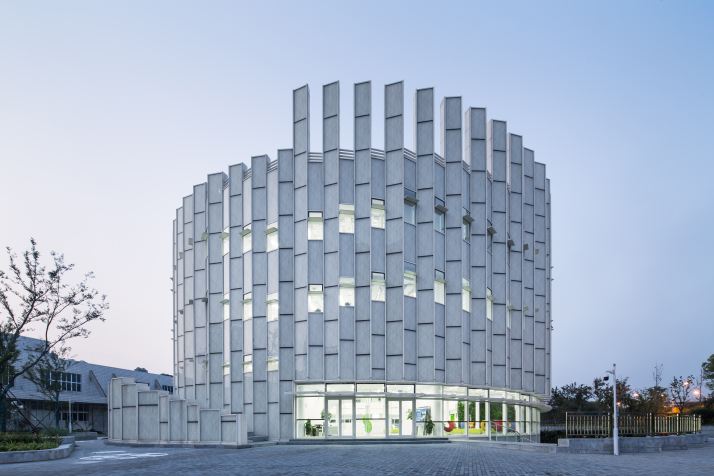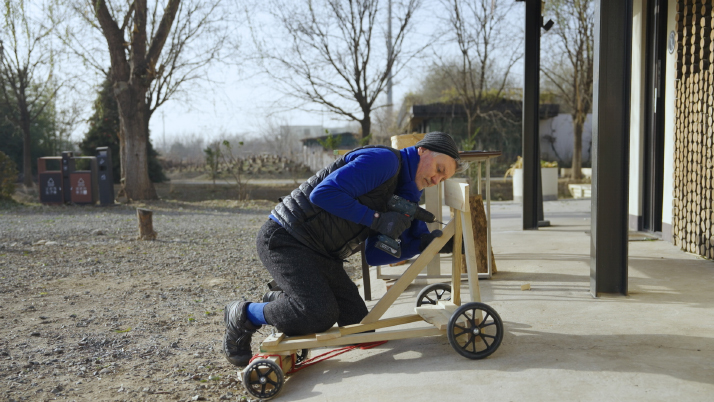| China |
| Danish architect builds livable oases in China | |
|
|
|
|
|
In Nanjing, the capital of Jiangsu Province, a cylindrical three-story building named the Nanjing Green Lighthouse stands out as one of the first "zero carbon" buildings in the Chinese mainland. It uses state-of-the-art technology to achieve energy consumption below 25 kilowatt hours per square meter per year, which can be offset by photovoltaic panels.
Its chief designer is Morten Holm, a Danish architect who has devoted himself to sustainable architecture for 30 years. Through the exemplary design, Holm aims to achieve more than just "zero carbon" buildings. He also aims to present a possible future of ultra-low energy consumption without sacrificing quality of life. A lighthouse "As its name suggests, the Nanjing Green Lighthouse is truly a house full of light. What makes it so special is that the whole indoor space is lit by natural daylight that enters through its sophisticatedly designed facade. With the assistance of 3D tools, a multidisciplinary team from my company Archiland calculated the optimal areas of window and skylight to achieve maximum efficiency with minimum use of high-performance facade openings," Holm told Beijing Review. "Imagine this, all the openings of the building are almost like sunflowers, rotating and dialing according to sun's motion. So it saves a lot of energy without getting too much heat load from the sun."  The Nanjing Green Lighthouse in Nanjing, Jiangsu Province (COURTESY PHOTO)
Holm paid special attention to making adjustments to suit microclimates and the natural surroundings when designing and selecting building materials. As Nanjing is a warm and humid city in the summertime, so many elements needed to be considered in the design of the building. Despite this, Holm said he enjoyed the process. "I've always enjoyed designing, creating and doing handwork. And I think the most fascinating thing about architecture is that it combines almost all types of design. It means I read a lot of books and articles that have nothing to do with design itself. It could be about human behavior, child education, political systems or even how to grow tomatoes," he said while discussing the very beginning of his journey in architecture. "And it is truly appealing that it can mobilize the left and right brains of people at the same time." Coming from a beautiful country in Northern Europe, Holm does not deny the Nordic roots in his architectural philosophy. To him, design is not limited to the form of objects, but how to provide people with a good life. "The Nordic society is known for its welfare model, and the Nordic design is known for its minimalistic style—these two are intrinsically linked," Holm elaborated. "The Nordic minimalistic style is actually function-oriented and pragmatic. But most importantly, it is people-oriented, which means one's creation should be in balance with nature, and the surroundings, the context made for people, without using unnecessary materials." He has also incorporated these insights into his design of sustainable architecture, seeking to minimize the negative environmental impact of buildings through improved efficiency and moderation in the use of materials, energy, space and the ecosystem at large. An urban oasis "The idea of sustainable or ecological design is to ensure that use of currently available resources does not end up having detrimental effects to a future society's wellbeing or make it impossible to obtain resources for other applications in the long run. It's about designing a society to cater for people with an attractive future," he said. To showcase a sustainable design, in 2022, he and his spouse took over the operation of an orchard on the outskirts of Beijing and transformed it into an educational ecological farm. To make full use of this land, Holm traveled across Denmark to learn from similar types of land use. From school gardens and educational farms for children to ecological city gardens and nature playgrounds, from the gardens of world-renowned restaurant NOMA to the Nordic tradition of curriculum-based school kitchens… Characteristics of all of these Danish spaces have been incorporated into FunFarmFam in Beijing, an outdoor space with multiple roles: a family orchard, an animal farm, a workshop studio, an organic kitchen and a nature school. Featuring over 8,000 fruit trees, the orchard provides fresh seasonal fruits, as well as raw materials for farm construction. "We use branches from the annual pruning of trees for wood fencing, shredded wood for floors and tree-trunk for chairs, while the roots from fallen trees can be transformed into pergolas, walls and interior ceilings… In a word, everything we need for life on this farm is harvested from the farm, " Holm said.  Morten Holm makes a cart for children out of wood harvested from the orchard at FunFarmFam in Beijing on December 8, 2023 (ZHANG KAI)
The farm also grows vegetables and herbs, and raises free-ranging domestic animals. In order to form a complete ecological cycle, the farm team takes ecosystem maintenance to the extreme: They even established a flourishing blanket of flowering groundcovers and built insect hotels to encourage pollinators to take up residence on the farm. Like the Nanjing Green Lighthouse, most of the projects Holm has designed, whether individual buildings or complexes, require years to finish, with the time from initial conception to the beginning of construction alone being three to five years. "But on this farm, we set up an operation system within 12 months. It has already become a place where people can see and learn about what ecological life and enjoying nature is about," he said. Ever since FunFarmFam opened in March 2022, it has been expanding its business collaborations with schools, companies and non-governmental organizations, so that both adults and children can get a firsthand impression of an idyllic and sustainable life. "We've heard about and talked about how to reach the "zero carbon" goal, how to live a circular lifestyle, how to cook healthy food, how to create nature-integrated design… All these things are not theory. They are here, on this farm," Holm said. Inspired by the idea of "learning beyond the classroom," the farm team also created their own hands-on and minds-on courses, pioneering playful learning to spark children's curiosity about the surrounding environment, and encouraging them to become a new generation who possess a stronger awareness of nature and really know how to live in harmony with it. "In my line of thinking, the greatest significance of a building is that it's a space, a location where people can unfold their life. In a playful manner, they can explore and enjoy it," Holm said. "So in the future, I hope to clone the operating model of FunFarmFam in other places in China, so that the big cities in the country can embrace more oases. Because all big cities need a breathing space, a living room that is close to the city centers, as a part of the support system of what livability and a good urban life is all about," he concluded. (Print Edition Title: Evergreen(er) Urban Spaces) Copyedited by G.P. Wilson Comments to kangcaiqi@cicgamericas.com |
|
||||||||||||||||||||||||||||
|